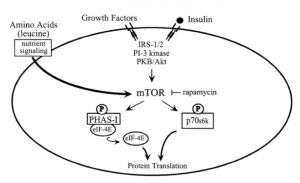Glutamine: Super Supplement? Or Overhyped and Worthless? Cutting through the Bull
One of several so called, “super-supplements”, to have hit shelves over recent decades is glutamine, the most abundant amino acid ...

One of several so called, “super-supplements”, to have hit shelves over recent decades is glutamine, the most abundant amino acid ...
If you eat a well balanced "healthy" diet, are supplements REALLY necessary to optimize progress? Learn some surprising reasons why ...
From boosting testosterone production & supporting lean muscle growth, to optimizing joint health & immune function, getting enough of this ...
You have also likely heard of ‘HMB’ which is a derivative of leucine. In fact the above pathway requires that ...
Mention the term ‘steroid hormone’ to most beginner bodybuilders and they may assume you are talking about the most coveted ...
So you’ve dieted hard, and trained even harder. Your mind and your body have been battered and depleted from the ...
When starting a diet, have you ever wondered why exactly hunger and cravings suddenly sky rocket? Obviously a reduced food ...
Question: “Will taking simple carbs after a workout negate the effect of growth hormone production from your workout and kill ...
Bodybuilders, and indeed all athletes looking to secure the performance edge would have at least a passing knowledge of the ...
The process of muscle growth is best stimulated with high volume using relatively moderate weights. But to get stronger faster, ...
We've all seen the Bruce Lee-types, the small men with profound strength, and the contrary, muscle men that are all ...
Leucine is the most important of the BCAAs. When it comes to signaling muscle building (protein synthesis), Leucine is King – it has been shown to increase protein synthesis by up to 145%! In terms of direct effect, it may be the single most important amino acid for hypertrophy.
As stated, leucine is one of the three branched chain amino acids (BCAAs), the other two are valine and isoleucine. Exercise leads to the oxidation of BCAAs as a primary source of fuel, as well as signaling pathways for recovery. BCAAs are unique in that they can lead to increased insulin or cortisol depending on the situation. Leucine is the most important of the 3 BCAAs for signaling muscle growth.
The presence of leucine in the body leads to the signaling of a pathway called mTOR, which is the same signaling pathway activated by growth factors like IGF-I. In fact, Leucine acts in a more direct way on the mTOR pathway than growth factors because it does not require as many intermediate steps.
mTOR pathway activity increases in response to muscle activity during hypertrophy, and decreases in activity during atrophy. IGF-1 activates AKT, GSK-3beta and mTOR to promote hypertrophy. The mTOR pathway leads to regulation of protein translation, with increased translation acting as a key regulatory point in skeletal muscle hypertrophy.
The activation of the Akt/mTOR pathway and its downstream targets, p70S6K and PHAS-1/4E-BP1, are directly involved in regulating skeletal muscle fibre size. So if your goal is to grow muscle, you have to activate this pathway, and often.
Post-training the mTOR pathway should be well unregulated and adding leucine can help facilitate a little better recovery.
Adding as little as 2 grams of leucine to meals consumed in the hours post-training encourages any amino acids already in your system to be put towards growth and repair by re-activating the mTOR pathway.
The mTOR pathway is also partly dependent upon insulin for maximal stimulus, so it is less effective in a low carb or low calorie state. That isn’t to say that leucine is not beneficial in the absence of carbohydrates, but it works synergistically with insulin for maximum anabolic effects. Leucine itself will still increase your uptake and use of plasma amino acids for protein synthesis, just not to the same magnitude, and it will have less of a glycogen rebuilding effect.
Leucine works synergistically with the other BCAAs, enhancing its effects, but it needs to be within a certain ratio. BCAAs with leucine in a ratio of about 4 to 1 with valine and isoleucine have been shown to be most effective for muscle building. When leucine intake is too far out of balance with the other BCAAs, it can lead to an imbalance in blood amino acid levels, reducing the anabolic signaling of leucine.
 The benefits of higher leucine BCAA formulas include: less muscle damage, less pain from training, increased performance, decreased fatigue, and greater muscle growth. Leucine enriched BCAAs are especially valuable for older trainees (35+) who have a harder time activating mTOR to build muscle.
The benefits of higher leucine BCAA formulas include: less muscle damage, less pain from training, increased performance, decreased fatigue, and greater muscle growth. Leucine enriched BCAAs are especially valuable for older trainees (35+) who have a harder time activating mTOR to build muscle.
When restricting calories, you may also use it with meals to maximize the benefits of food protein. Leucine is most effective when taken with other BCAA’s, essential amino acids or protein, or with elevated insulin levels. In each of these cases there is an exponential benefit to using higher levels of leucine.
Leucine can be used effectively at almost any time. It does however need to work in somewhat of a pulse. The mTOR pathway can only be stimulated every 3-4 hours. This is one of the reasons that eating higher protein meals every 3-4 hours tends to be more beneficial for hypertrophy.
Protein synthesis comes in pulses. When looking at a comparison between the levels of protein synthesis observed following three separate feedings of 4oz of meat, spaced 3 hours apart, versus 1 feeding of 12oz of meat, the pulsing of the amino acids every 3 hours resulted in greater overall protein synthesis.
Protein synthesis declines between 90 to 120 minutes after eating a high-protein meal, even though the blood still contains elevated levels of amino acids. At this point, the pathway becomes saturated and actually shuts down, there is no activating it any further. After 3-4 hours however, ingesting leucine (or leucine and carbs) is all you need to do to re-stimulate protein synthesis and take advantage of the leftover amino acids still circulating in your system.
 Insulin also stimulates the mTOR pathway, but if your goal is to stay lean, leucine is the better choice to make better use of your protein.
Insulin also stimulates the mTOR pathway, but if your goal is to stay lean, leucine is the better choice to make better use of your protein.
A key time of course to take leucine is around training time. For maximal hypertrophy benefits, you want the mTOR pathway to be stimulated during and after training. Peri-workout and post-workout leucine supplementation is probably the most important. To be safe, the meals after training could also contain some leucine. The effects of training can throw off the signaling timetable, so having all of your bases covered gives you the best chance to maximize protein synthesis.
Most BCAA supplements will have a higher ratio of leucine to valine and isoleucine. But when using BCAA’s pre-and intra-workout, you must remember that you oxidize BCAA’s for training fuel as well. So not all the leucine ingested will be used to signal anabolism. This function of BCAAs is part of the muscle sparing benefits they have and helps to decrease the damage to your muscles during training.
As I mentioned, take leucine two hours after training to extend muscle protein synthesis.
Leucine is just the signaling agent for synthesizing protein, you still need building blocks for protein synthesis to occur. This is where Essential Amino Acids (EAAs) come in.
We know leucine works better alongside other BCAAs, which are essential amino acids, but it actually works better when you have more of the EAAs. You should consume leucine in a stack with all of the EAAs immediately after training, and then again two hours later. You can take BCAAs containing a high leucine count pre, and intra-training, or add them to food meals where the food is providing the other EAAs. If you’re serious about building muscle, research shows that it’s also beneficial to take leucine two hours after each meal to further support protein synthesis. This is especially important for hardgainer types or people that tend to run very high metabolisms. It is important to keep the body in an anabolic state as often as possible.
EAAs provide the building blocks for protein synthesis, but they also activate the mTORC1 signaling pathway that is also essential for muscle building. The most effective way to use leucine for increased workout recovery and protein synthesis is to have a large protein shake post-workout, followed by an EAAs mix which should contain at least 40% leucine according to one study. Other research suggests that as long as you have at least 3-4g of free l-leucine with the amino acids, you will still get the benefit of the leucine. I tend to suggest the latter for simplicities sake, and it also seems to be well supported.